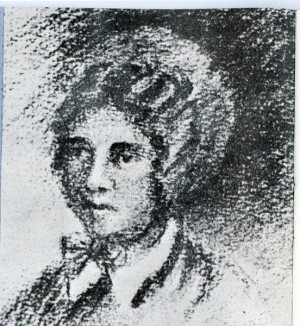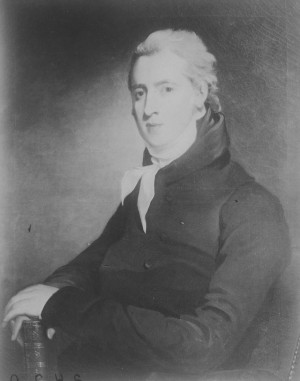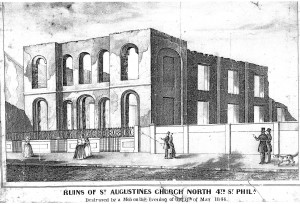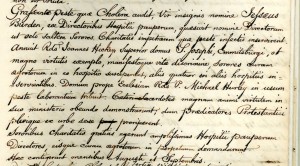Lately, there has been a fair amount of news coverage (“Fates Of Irish Workers Sealed In Mass Grave”, “Pennsylvania Ghost Story Leads to Murder Mystery”, "CNN Visits Penn Museum to Follow Story of "Duffy's Cut" Excavations in Malvern, PA") about the mystery surrounding “Duffy’s Cut,” a stretch of land in Chester County where, during the summer of 1832, 57 Irish laborers died. The men were hired by labor contractor Philip Duffy to construct mile 59 of the Pennsylvania and Columbia Railroad. The cholera epidemic that was ravaging parts of the U.S., including New York City, spread to Philadelphia and reached the laborers' camp in mid-August. Within two and a half weeks, all of the men were dead.
All of the deaths were blamed on the disease; however, historical documents and local stories suggest that some of the victims may have been murdered by locals, antagonistic to Irish Catholics, who wanted to prevent the outbreak from spreading. A few years ago, scholars and other interested parties began an archeological dig at the site of the mass grave to try and determine whether foul play had indeed occurred.
Although downplayed in histories concerning the 1832 cholera epidemic, the toll that the disease took on Philadelphia that summer was high. Many residents fled from the city to the countryside. August proved to be the worst month with well over a hundred cases a day reported. A significant number of those cases resulted in death. The worst days in the city were August 6, when there were 176 cases and 71 deaths, and August 7, when there were 136 cases and 73 deaths reported.
There was a fairly organized and concerted effort on the part of the medical community in the city during the early months of the outbreak. However, by August medical personnel were overwhelmed and began to seek outside help. The Committee of the Almshouse, later known as Philadelphia General Hospital, asked Bishop Kenrick if he could request the help of the Sisters of Charity to serve as nurses. The order, founded by Elizabeth Ann Seton, already had a presence in the city. In 1814, at the request of then Bishop Egan and Fr. Michael Hurley, pastor of St. Augustine’s Church and close friend of Mother Seton, sisters began working in St. Joseph's orphanage.

Sister Rose White, first sister servant of St. Joseph's Home, no date
Kenrick agreed to contact the order. In addition to the five sisters already in Philadelphia, eight others were sent from the motherhouse in Maryland. They lived and worked in the Almshouse and other hospitals, including St. Augustine Church, which Fr. Hurley had turned into a makeshift hospital under the supervision of Dr. Oliver H. Taylor.
Four Sisters of Charity were also called upon to minister to the dying men at Duffy’s Cut. Their presence was recorded from the accounts of an eyewitness; however, no official record of their mission exists. Relevant documents may have been destroyed in the fire at St. Augustine’s several years later. Ironically, although most of the patients cared for by the Sisters of Charity at St. Augustine were recorded as being non-Catholic, the church was not spared by Protestant nativists when it was burned to the ground during the riots of 1844.
Cholera had run its course in Philadelphia by early September. None of the sisters who ministered in the city and at Duffy’s cut during the outbreak perished from the disease. Their assistance, as well as that of Bishop Kenrick and Father Hurley, was publicly recognized by the city. The Board of Health and the Almshouse Committee recognized their efforts, and the city awarded silver plates to the sisters and thirteen physicians who had played a prominent role during the outbreak. The sisters declined the offer, instead asking that the money used to make the plates be used as funds for the orphanages and schools that the order administered.
In his diary, Bishop Kenrick commented on the noteworthy efforts of the sisters and priests during the outbreak: “…displaying an example of heroic fortitude, with certain peril to their lives, the Sisters took charge of the pest-stricken patients in that Hospital. Four others of the Sisters gave their services in other hospitals…priests proved their character and their strong virtues, caring for the sick in the exercise of the sacred ministry; while non-Catholic ministers generally fled from the city.”
Kenrick was one among many prominent religious figures of all Christian denominations in the United States and Britain who viewed the outbreak as punishment for people’s sins, specifically those dealing with the overindulgence of food and drink. And although Kenrick greatly assisted those affected by the disease, in a letter to Bishop Rese of Detroit, Kenrick shares his view of the outbreak as sort of a blessing in disguise in that it allowed many to reflect on their lives and come to terms with death. He writes, “The cholera has done great good in Philadelphia. Many are prepared for death, frightened from daily examples of unexpected deaths.”
References: McGowan, Francis X., ed. Historical Sketch of St. Augustine's Church, Phila., Pa. Philadelphia: The Augustinian Fathers, 1896.
Prendergast, Edmond, ed. Diary and Visitation Record of the Rt. Rev. Francis Patrick Kenrick, 1830-1851. Lancaster, Pa: Wickersham Printing Co., 1916.
Watson, William. "The Sisters of Charity, the 1832 Cholera Epidemic in Philadelphia and Duffy's Cut." U.S. Catholic Historian 27, no. 4 (Fall 2009): 1-16.
For more information on Duffy's Cut see:
Watson, William E. et al. The Ghosts of Duffy's Cut: The Irish Who Died Building America's Most Dangerous Stretch of Railroad. Westport: Praeger Publishers, 2006.





